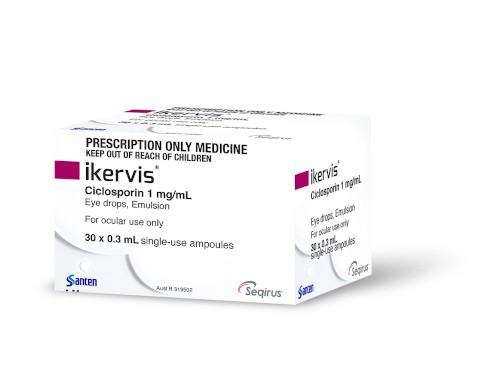Industry News
New Study Provides Real-world Insights Into Managing Severe Keratitis in Dry Eye Disease
 PERSPECTIVE, a prospective, multicentre, observational study recently published in Ophthalmology and Therapy, has expanded the real-world evidence base for the use of ciclosporin 0.1% cationic emulsion (CE) in managing severe keratitis in adults living with dry eye disease (DED) insufficiently controlled by artificial tears (ATs).
PERSPECTIVE, a prospective, multicentre, observational study recently published in Ophthalmology and Therapy, has expanded the real-world evidence base for the use of ciclosporin 0.1% cationic emulsion (CE) in managing severe keratitis in adults living with dry eye disease (DED) insufficiently controlled by artificial tears (ATs).
Conducted at 44 ophthalmology clinics throughout Northern Europe*, the study recruited a total of 472 participants based on a diagnosis of DED and severe keratitis, who were considered by their treating physician to have shown insufficient improvement with their current AT treatment. The study examined real-world clinical practice and patient-reported outcomes on the effectiveness, tolerability and safety of using Ikervis once-daily.
According to ophthalmic surgeon, and Head of the Corneal Unit, Sydney Eye Hospital, Professor Stephanie Watson, Sydney, studies examining how dry eye disease can be effectively managed, and treatment options that can help address symptoms while remaining well tolerated, are invaluable for patients’ long-term eye health.
“PERSPECTIVE provides real-world evidence and insights into the clinical applicability of Ikervis, and how it can potentially make a real difference to patients’ vision and symptom management. The positive patient-reported outcomes should contribute to increasing prescriber confidence in the use of Ikervis to treat severe keratitis in dry eye disease,” said Prof Watson.
PERSPECTIVE identified significant improvements in mean CFS score from baseline over the 12-month treatment period (mean change, -1.42; p<0.0001), with incremental reductions observed from week 4. Overall, 77.5 per cent demonstrated a reduction in CFS score from baseline. Severity of eyelid erythema significantly decreased from baseline at week 4 through to month 12 – moderate-to-severe erythema was reported in 30.8 per cent of patients at baseline compared to 9.2 per cent at month 12 (p<0.001). There was also a statistically significant reduction in conjunctival erythema from baseline at week 4, maintained through month 12, with moderate-to-severe conjunctival erythema observed in 28.3 per cent of patients at baseline and 9 per cent at month 12 (p<0.001).
Both tear film breakup time and ocular symptom severity demonstrated significant improvements at all study visits through month 12 (p<0.001). Furthermore, of the 280 adverse events (AEs) reported during the study period, 101 were considered treatment-related, with the majority of the total AEs (88.6 per cent) non-serious in nature. By the end of the study, most treatment-related AEs (73.3 per cent) had resolved, or were resolving. Patient evaluation of tolerability revealed a high level of satisfaction throughout the 12-month treatment period. Overall, 77 per cent of patients reported tolerability with Ikervis to be good, or very good at month 12. Ocular symptoms assessed during the study comprised foreign body sensation, burning/stinging, itching, pain, blurred vision, sticky feeling and photophobia. Symptom severity was recorded using a 4-point scale (none, mild, moderate, and severe). Each of the examined symptoms were significantly improved from week 4 following initiation of Ikervis, and at all subsequent study visits (p<0.001), reflecting other recent, real-world data on the use of Ikervis in severe keratitis in DED.
“While randomised controlled trials are usually considered more reliable, real-world evidence reflects key aspects of clinical practice. The real-world data collected in PERSPECTIVE is of practical benefit, and may help inform the use of Ikervis in a real-world setting,” Prof Watson said. “The positive patient feedback is encouraging and supports the outcomes achieved with Ikervis. The majority of those living with severe keratitis in dry eye disease reported significant improvements in their condition, and generally felt better without experiencing any major side-effects. Collectively, these findings should provide prescribers and patients alike with confidence in the clinical applicability of Ikervis in the management of severe keratitis from DED,” said Prof Watson.
DED is a chronic eye condition and significant health burden in Australia and is likely to affect more than seven per cent of the population. Many living with dry eye attempt to self-manage their symptoms using over-the-counter ATs.
“Artificial tears generally only provide short-term relief and lubrication at the eye surface, which may not be sufficiently effective for cases of severe keratitis associated with DED. Subsequently, in cases of severe keratitis from DED, there is a significant, unmet clinical need for a treatment option which addresses the underlying pathophysiology of DED, offering long-lasting, reliable disease control. ” Prof Watson said.
Ikervis harnesses cationic nanoemulsion technology to deliver ciclosporin, a calcineurin inhibitor immunosuppressant agent, to the eye surface, which works to reduce dry eye signs and symptoms by inhibiting the production and/or release of pro-inflammatory cytokines. The efficacy and safety of Ikervis were evaluated in two pivotal, Phase III, randomised, double-masked, vehicle-controlled clinical studies in adult DED patients with severe keratitis.
The PERSPECTIVE study captures a real-world approach to DED therapy in patients living with severe keratitis, with outcomes reflecting key factors of current clinical practice. Specifically, patients were allowed to concomitantly treat with steroids and ATs during the study, and were not required to undergo a wash-out period prior to initiation of Ikervis. As a multifactorial condition, DED management strategies usually necessitate combination therapy to attain effective symptom relief. Therefore, these results may provide a representation of the expected outcomes of Ikervis use in a real-world setting.
“Dry eye can cause severe keratitis and symptoms of discomfort and visual disturbance. Treatment options utilising novel approaches to stabilising symptoms, and addressing the problem at the eye surface, are therefore critical,” said Professor Fiona Stapleton, School of Optometry and Vision Science, University of New South Wales, Sydney. “Whilst the efficacy and safety of Ikervis has been tested in robust clinical trial settings, this study provides important evidence regarding its tolerability and long-term effectiveness in real-world practice in severe keratitis from DED. Optometrists and ophthalmologists should be aware of the signs and symptoms of dry eye, and treat the condition promptly, to help patients manage their eye health and improve overall quality of life,” Prof Stapleton said.
To learn more about the PERSPECTIVE study, watch Prof Geerling’s virtual, live-streamed presentation from Germany to Brisbane, Sydney, Melbourne, and Adelaide respectively today – Wednesday, March 29 – between 8.00pm – 9.00pm AEDT. Prof Geerling’s presentation will be followed by a Q&A session. To register, visit bit.ly/eyecare-perspective


